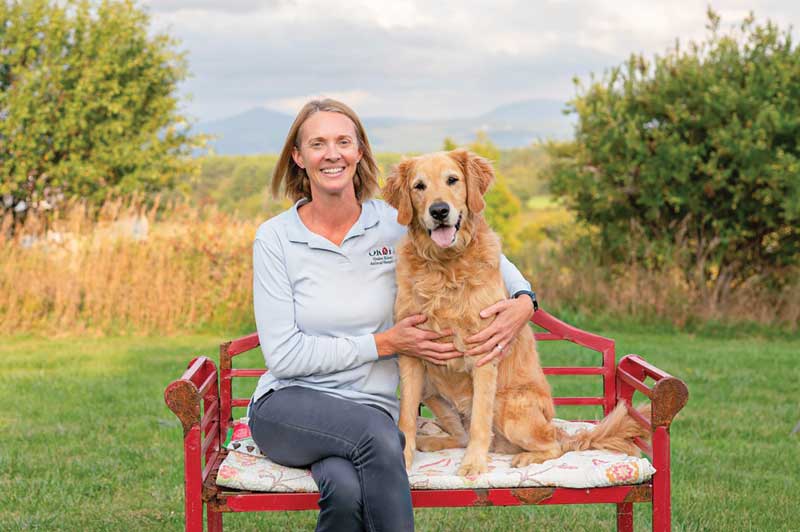
You have a superstar technician and promote him to practice manager, but will he succeed? Absolutely, if you follow the steps of Karen Bradley, DVM, and hospital administrator Erin Preston, CVPM, co-owners of Onion River Animal Hospital (ORAH) in Berlin, Vt.
Josh Blakemore, RVT, joined the eight-doctor practice as a lead veterinary technician. “After working with our hospital for one year, Josh started co-leading team meetings and supervising our support team,” says Preston. “We encouraged Josh to join the Veterinary Hospital Managers Association (VHMA). He attended the 2022 VHMA conference where he was inspired to work toward becoming a certified veterinary practice manager (CVPM).”
Blakemore earned his CVPM credential, took online business classes, and completed his degree all in one year. Hospital leaders supported his efforts with CE and tuition allowances and continued growing his management responsibilities.
Now a practice manager, Blakemore will take another step up the leadership ladder when Onion River Animal Hospital opens a second location in 2025. Preston will lead the new hospital and pass the torch to Blakemore to run Onion River Animal Hospital.

Dr. Bradley knows easing potential leaders into management responsibilities, funding formal education, and supporting professional memberships works. She provided similar resources for Preston. “Erin grew up in our practice,” says Dr. Bradley. “We identified her as a leader.” Preston began her career with ORAH as a technician in 1998 and rose to practice manager in 2007. She graduated from Purdue University Veterinary Management Institute in 2011, became a CVPM in 2014, and earned a degree from the Community College of Vermont. Now with 23 years of experience, Preston is co-owner and
hospital administrator.
Too often, a superstar employee is promoted to manager and has no idea where to begin. Help new team leaders and managers succeed in their new roles with these strategies.
1) Provide a job description. Hospitals may have different levels of managers, including team supervisors, assistant hospital manager, office manager, practice manager, director of operations, and hospital administrator. A job description defines all activities a manager will need to successfully complete and should describe categories of personnel, financial, administrative, marketing, and client satisfaction duties along with the tasks in each area.
Your job description also may include educational requirements, skills needed, physical obligations, and who the manager reports to. It also ensures critical tasks (i.e. payroll) do not get overlooked because the manager thought the practice owner handled payroll and vice versa. Job descriptions make expectations and responsibilities clear for both practice owners and managers.

2) Transfer trust to the new manager. When an employee is promoted from within, the pecking order among the team changes and may cause friction. Let all employees know about the new manager’s role and responsibilities by sending emails, announcing during a staff meeting, and posting congrats on an employee bulletin board.
In the announcement, practice owners should describe why they chose to promote the employee, share credentials and responsibilities, and ask for teammates’ support of the new manager.
3) Write standard operating procedures (SOP). Chances are, there is little to nothing documented for managers. Writing SOPs is a great onboarding process and creates this documentation for ongoing practice use. Your manager SOP should answer, “How do I…?” (i.e. review key performance indicators, run payroll, approve paid-time-off requests, enroll new hires in online courses, etc.)
Too often, a manager leaves the hospital, and no one knows how to do the job because it was all in the former manager’s head. A practice can suffer and even fail in the hands of an untrained manager.
4) Meet consistently. While practice owners and managers can exchange emails and ask quick questions about daily operations, set aside focused time to discuss bigger picture management issues such as key performance indicators, benefits, practice growth opportunities, and personnel. Follow an agenda so you make the most of your management meetings. Consider a standing weekly meeting such as lunch every Wednesday. If possible, meet at a restaurant or offsite location where you can discuss management issues uninterrupted and privately. Consistent meetings will help both new and seasoned managers excel through communication and collaboration with practice leaders.
5) Find your tribe. Networking with other practice managers lets you exchange resources, have sounding boards, and connect with colleagues who get the daily challenges you face as a manager. Find your tribe through veterinary management groups, local practice manager meetings, and online communities on social media. If your area does not have a practice managers’ group, consider starting one. Ask pharmaceutical and distributor reps to help sponsor speakers and find venues.
6) Engage with mentors. Mentoring pairs an experienced professional, who acts as a role model, with a less-experienced professional to provide guidance and advice.1 Mentors help mentees learn new skills, develop confidence, and make better decisions.
Find internal mentors, such as a practice manager, who coaches a new team leader. When beginning a mentor relationship, meet to discuss how to ask for help, when is the best time to ask, and what to do when the mentor is not available.2 Have check-in meetings led by the mentee to discuss goals, celebrate accomplishments, collaborate on new challenges, and debrief tough cases. Mentors can meet in-person or virtually.
Seek external mentors through:
- VHMA Mentor Program, a VHMA membership benefit that pairs mentors with mentees
- MentorVet, an evidence-based mentorship and professional development program that promotes early-career well-being for veterinarians
- Pawsibilities, a nonprofit organization that aims to improve the recruitment and retention of underrepresented groups in the veterinary profession
- Veterinary Information Network’s Veterinary Mentorship Academy offers globally accessible opportunities to receive and offer mentorship for companion animal veterinarians at any stage of their careers. Virtual Veterinary Internship is a year-long virtual curriculum that rotates through all major subspecialties
Knowledge is half the equation with the other being an innate sense of leadership, advises the Young Entrepreneur Council.3 “Identify the right person with leadership qualities, not just senior staff,” advises Adrienne Turner, MBA, LVT, CVPM, SHRM-SCP, CEO of Windcrest Animal Hospital Group, which has five hospitals including a 24/7 emergency/urgent care and rehabilitation in Delaware.
“As a five-site hospital group, our objective from day one of employment is to identify and grow all team members who have the desire and skills necessary to advance their careers.”
ResourcesCheck out these programs for veterinary management training: VHMA: Rising Manager Training Program VHMA: Certified Veterinary Practice Manager Veterinary Management Institute Penn Foster: Veterinary Practice Management Certificate VETgirl: Practice Management Certificate NAVC: Certified Veterinary Business Leader |
Wendy S. Myers, CVJ, has taught communication and client service skills for more than two decades. As founder of Communication Solutions for Veterinarians, she teaches practical skills through online courses, onsite coaching, and conferences. Myers was a partner in a specialty and emergency practice. Visit YouTube.com/csvets and Csvets.com for more.
References
- VMHA Mentor Program. Available at: https://www.vhma.org/resources/mentorprogram. Accessed Oct. 11, 2023.
- Burns K. How to Make Mentorship Work in Veterinary Practice. AVMA. Available at: https://www.avma.org/news/how-make-mentorship-work-veterinary-practice. Accessed Oct. 11, 2023.
- Expert panel. Identifying Leadership Potential in Employees: Eight Critical Traits. Young Entrepreneur Council. Available at: https://www.forbes.com/sites/theyec/2020/02/10/identifying-leadership-potential-in-employees-eight-critical-traits/?sh=30e1a9756c0a. Accessed Oct. 10, 2023.
